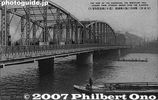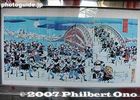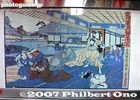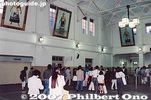 Last additions - Ryogoku 両国 Last additions - Ryogoku 両国 |

Old postcard showing Ryogoku Bridge over Sumida River and the old Kokugikan in the distance.Apr 10, 2007
|
|

Sumo Photo Museum 相撲写真資料館Apr 10, 2007
|
|

Sumo Photo MuseumApr 10, 2007
|
|

Next to a portrait studio is a small garage with sumo photos on the walls.Apr 10, 2007
|
|

Matsuzaka Inari Shrine. On the right is a small, roofed stone monument engraved with the names of 20 of Kira's samurai who died during the attack. The stone monument was built by a local shopkeeper.Apr 10, 2007
|
|

Inside Sumo Photo MuseumApr 10, 2007
|
|

Painting depicting the retainers proceeding to Ryogoku to get Kira's head.Apr 10, 2007
|
|

Site of Lord Kira's Estate or Honjo Matsuzaka-cho Park. Lord Kira was the villain in the famous Chushingura vendetta. 吉良邸跡・本所松坂町公園Apr 10, 2007
|
|

The shaded part of the map shows the area of the original estate and the black square shows the area of this park. It was a huge estate.Apr 10, 2007
|
|

The walls inside have panels such as this one. Painting depicting Lord Asano's attack on Lord Kira at Edo Castle.Apr 10, 2007
|
|

Pet memorial, Eko-inApr 10, 2007
|
|

Inside the park is an Inari Shrine.Apr 10, 2007
|
|

This little park was purchased in 1934 by locals and donated to Tokyo to mark the site of Kira's estate. Free admission.Apr 10, 2007
|
|

Pet memorial, Eko-in temple.Apr 10, 2007
|
|

Marker for the Ako retainers' avenging their Lord who was forced to commit seppuku when he attacked Lord Kira at Edo Castle.Apr 10, 2007
|
|

Apr 10, 2007
|
|

Apr 10, 2007
|
|

CemetaryApr 10, 2007
|
|

The temple itself looks so modern and ordinary that it does not look like a temple.Apr 10, 2007
|
|

Memorials for those who died in maritime disasters.Apr 10, 2007
|
|

Sumo monument in Ekoin temple. Sumo matches were held here regularly from 1833 to 1909 when the Kokugikan sumo stadium was built.Apr 10, 2007
|
|

The temple has many other memorials and monuments.Apr 10, 2007
|
|

Apr 10, 2007
|
|

Gate to Eko-in temple where early sumo tournaments were held. The temple was originally built in 1657 for the repose of over 100,000 people who died in the Great Fire of Meireki (Furisode Fire). 回向院Apr 10, 2007
|
|

Sumo monument in Eko-in temple. Sumo was first held here in 1768. 力塚Apr 10, 2007
|
|

Shop selling sumo goods.Apr 10, 2007
|
|

Tatsunami-beya sumo stable.Apr 10, 2007
|
|

Yokozuna statueApr 10, 2007
|
|

Edo-Tokyo MuseumApr 10, 2007
|
|

Map of Ryogoku. The Kokugikan sumo arena is north of the station, as well as the Edo-Tokyo Museum.Apr 10, 2007
|
|

Ryogoku Station exit. Only one sumo portait hangs here.Apr 10, 2007
|
|

Present entrance to Ryogoku Station (during spring festival).Apr 10, 2007
|
|

Old entrance to Ryogoku Station with a high ceiling and giant portraits of sumo wrestlers.Apr 10, 2007
|
|

JR Ryogoku Station. This part of the station building is now a beer hall. The train station entrance has moved to the right of this.Apr 10, 2007
|
|

JR Ryogoku Station platform for the Sobu Line.Apr 10, 2007
|
|

JR Ryogoku Station 両国駅Apr 10, 2007
|
|
|
|
|
|
|
|
|